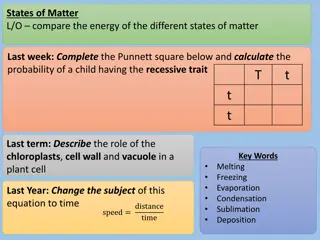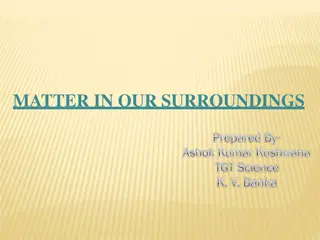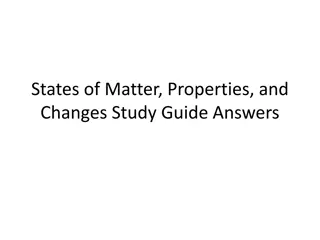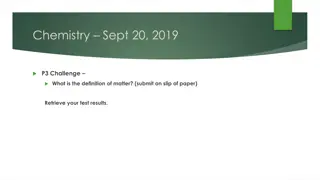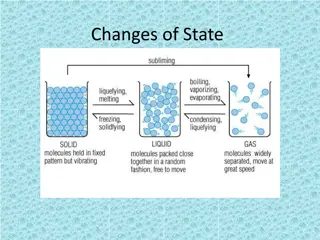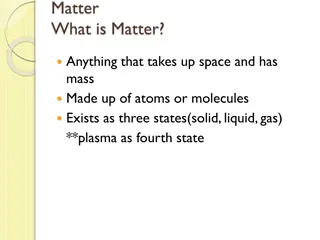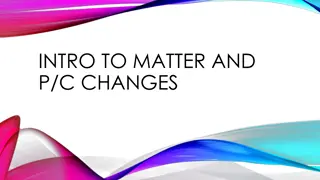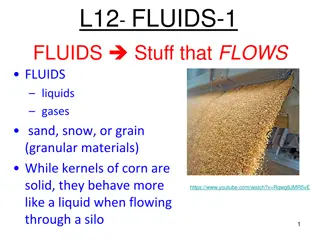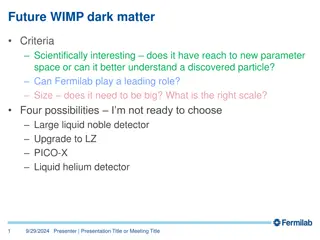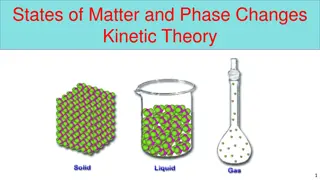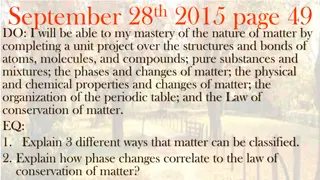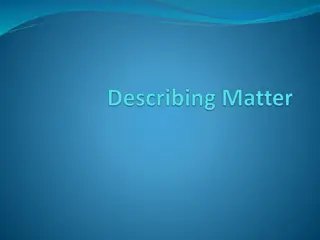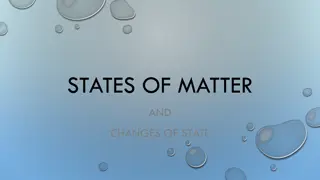Understanding Changes of State in Matter
Explore the intriguing world of changes of state in matter, from melting to deposition. Learn about the various energy changes, particle behavior, and how substances transition between states by adding or removing energy like heat. Discover the differences between endothermic and exothermic changes and the significance of temperature in measuring particle movement and energy.
Download Presentation

Please find below an Image/Link to download the presentation.
The content on the website is provided AS IS for your information and personal use only. It may not be sold, licensed, or shared on other websites without obtaining consent from the author. Download presentation by click this link. If you encounter any issues during the download, it is possible that the publisher has removed the file from their server.
E N D
Presentation Transcript
Changes of State Changes of State Melting, Freezing, Vaporization, Evaporation, Condensation, Sublimation, Deposition OH MY!
Learning Learning Objectives Objectives I can describe the 6 changes of state (melting, freezing, vaporization, condensation, sublimation, and deposition) in terms of what happens to the energy and spacing of the particles. I can describe the differences between endothermic and exothermic changes of state.
What is a change in state or phase change? What is a change in state or phase change? A change of state is changing a substance from one physical form to another. Phase Change A reversible physical change that occurs when a substance changes from 1 state to another. Physical change means the substance only changes it s appearance; it s still the same substance!
How do substances change state? How do substances change state? A substance can change from one state to another by adding or removing ENERGY! One type of energy is HEAT so we are adding heat or removing heat to change states
What happens when you add energyheat? What happens when you add energy heat? The more energy/heat (higher temperature) will make the particles move faster. The more energy/heat will make the particles spread out more and attraction decreases.
Temperature Temperature Temperature the measure of particles moving (speed) and therefore a measure of it s energy. - Higher temperatures = Fast moving particles - Lower temperatures = Slow moving particles.
Types of Energy Changes Types of Energy Changes Endothermic Heat goes INTO an object from its surroundings. Exothermic Heat is RELEASED from an object to the surroundings.
What are the changes in state? What are the changes in state? Energy is absorbed - Endothermic Melting Vaporization Sublimation Freezing Condensation Deposition Energy is released - Exothermic
Change of state: MELTING Change of state: MELTING Melting: The change of a solid to a liquid. Energy (HEAT) must be added to the substance to make it melt. Endothermic
Melting Melting As the substance is melting, the particles are moving faster because energy/heat was added. The particles are also spreading out more because the attraction is less and they are going from a solid (packed together) into a liquid (loosely packed)
Change of state: Vaporization Change of state: Vaporization Vaporization: The change of a liquid to gas. Energy/heat must be added to make it evaporate Endothermic
Vaporization. Vaporization . The particles are moving even faster as they go from a liquid to a gas The particles are spreading out farther and attraction is decreasing.
Change of state: SUBLIMATION Change of state: SUBLIMATION Sublimation: The change of a solid directly to a gas. Energy must be added. Think: As dry ice is exposed to a warmer temperature (more energy) it will begin to look like its steaming. Particles are moving faster as the solid turns into a gas Endothermic Example: Dry ice
Reverse Reverse REVERSE!
What happens when you remove energyheat? What happens when you remove energy heat? If you remove energy/heat (lower temperature) the particles move slower The less energy/heat will make the particles move together more and attraction increases.
Change of state: FREEZING Change of state: FREEZING Freezing: The change of a liquid to a solid. Energy/heat must be removed to make the substance freeze. Exothermic
Freezing. Freezing . As energy/heat is removed and the substance is freezing, the particles are starting to move slower. As energy/heat is removed to freeze, the particles are getting closer and attraction is increasing.
Change of state: CONDENSATION Change of state: CONDENSATION Condensation: The change of a gas to a liquid. Energy/heat must be removed to change a gas to a liquid. Exothermic Example: All the steam from a hot shower creates condensation (water droplets) on the mirror.
Condensation Condensation As energy/heat is removed in condensation, particles are moving slower. As energy/heat is removed in condensation, the particles get closer and the attraction increases.
Change of state: Deposition Change of state: Deposition Deposition: The change of a gas directly to a solid. Energy must be removed (taken away). Particles are moving slower as the gas turns into a solid Exothermic Example: Frost on windows
Wrap up! Wrap up!
Energy is absorbed - Endothermic Energy is released - Exothermic
Phase Changes Phase Change Phase to Phase Ex. Solid to Gas Solid to Liquid Liquid to Solid Liquid to Gas Gas to Liquid Solid to Gas Gas to Solid Endothermic or Exothermic? Endothermic Exothermic Endothermic Exothermic Endothermic Exothermic Melting Freezing Vaporization Condensation Sublimation Deposition
Points Where Phase Changes Occur Points Where Phase Changes Occur Melting Point Temperature at which a solid turns to a liquid. Freezing Point -Temperature at which a liquid turns to a solid. Boiling Point -Temperature at which a liquid turns to a gas. Condensation Point - Temperature at which a gas turns to a liquid.




